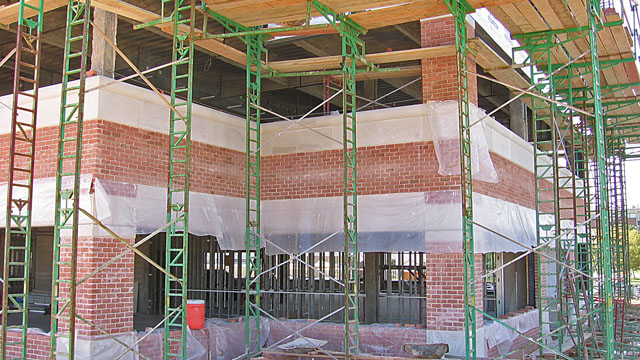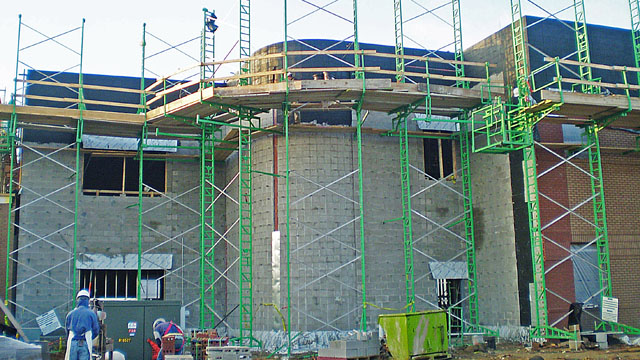January 30, 2012 7:00 AM CST
1. “People look at tight jobs as a production killer, but we see them as an opportunity in disguise,” says Everett Greenstreet III of Senate Masonry in Kensington, Md. “We were surprised to find out that’s where our elevating scaffolding really performs best. I personally watched my guys set up 10 Non-Stop towers in about 40 minutes on a very complicated wall. You can’t do that with frames or mast-climbers; it would take five hours. Five hours! How many blocks can you lay in five hours? Plus, my guys are laying an extra hour a day, because we never stop to hop planks. Add that up.”
2. According to Jeffrey Jones of Jones Masonry in Biloxi, Miss., “When it comes to cut-up jobs, it goes in place absolutely faster than frames. I’ve been running work for about 10 years, and it’s the best for masons. Of course, I grew up around crank-up scaffolding, and I was taught to use it everywhere possible. Anytime you use a crank-up system, you’re way ahead.”

Setting up outside corners is the same as setting up frames, just set one tower passed the corner, and lap your planks onto it.
3. Jeffrey Jones’ brother, Matt, tells about an extremely tight job site in downtown New Orleans: “It’s a huge benefit on this job. We’re using the Non-Stop Standard-Duty that we can move and set up by hand. We put it up on the second floor roof, set it up by hand, and laid those walls in no time. We used it inside for the gymnasium walls, where we had practically no access. We set it up by hand in there and ran those walls up without stopping.”
4. Brint Callaway, a factory rep for Non-Stop Scaffolding, had a tricky layout with two inside corners, a radius, and an outside corner all set up together. (See Photo 3.) The towers were set to the brick line, and then the masons’ walkboard arm was extended to the block line and the blocks were laid. The scaffold was lowered, the arms were slid back to the brick line, the scaffold was restocked with bricks, and the bricks were laid without having to shift the scaffold.
“We assembled the towers on the ground, 36 feet high, and then tilted them up with the forklift,” says Callaway. “The whole process took about an hour, and we were done. We had the entire scaffold ready to go for 30-foot-high walls, three corners and a radius, and nobody left the ground. Moving to the next wall takes about one-quarter of the time it takes to tear down and rebuild frames.”

5. Drew Lenn of D. Lenn Masonry in Pensacola, Fla., faced such a job recently. “We were doing a public library and only had about 10 feet of room on one long side,” Drew says. “It was easy with our elevating scaffolding. I just put a pipe on one fork and picked up the 36-foot-high towers from the side. I drove up in the hole, set them down at the wall, and backed out. We landed a tower about every 10 minutes. We fed the scaffold from the end; we have five boards back there so we just rolled everything down the wall. We would have been there forever with frames.”

At Non-Stop we developed a trap-door that installs in the laborers’ platform, and a bracket to mount the hoist in a fixed position above the trapdoor. (See Photo 4.) The advantages of this new method are many. The hoist can safely lift its full rated capacity and height (up to 200 feet). The trapdoor can be mounted anywhere along the length of the scaffold, reducing material-handling distance. Multiple units can be installed on a long scaffold.
Scaffolding tricks for tight job sites
Elevating scaffolding proves to be king of cut-up jobs

Photo 1: The tower in the corner is set first, and the others are simply set where needed to tie into the other runs.
In the race for profits in an ever-tightening market, mason contractors are using every trick in the book to increase production and cut job costs. The use of elevating scaffolding on tight, cut-up jobs has had surprising results.1. “People look at tight jobs as a production killer, but we see them as an opportunity in disguise,” says Everett Greenstreet III of Senate Masonry in Kensington, Md. “We were surprised to find out that’s where our elevating scaffolding really performs best. I personally watched my guys set up 10 Non-Stop towers in about 40 minutes on a very complicated wall. You can’t do that with frames or mast-climbers; it would take five hours. Five hours! How many blocks can you lay in five hours? Plus, my guys are laying an extra hour a day, because we never stop to hop planks. Add that up.”
An old myth busted
For the longest time, mason contractors have believed that elevating scaffolding is only for long, straight walls. So, what’s the secret that makes it so easy to use on complicated layouts? It’s the use of independent towers that do not have to be X-braced together. The seven-foot-wide towers are dropped in place with a forklift at the rate of about one tower every eight minutes. But, since they do not have to be X-braced together, they simply are landed about seven feet apart, to follow the contour of the wall, be it a radius wall or saw-tooth walls with lots of inside and outside corners. It turns out that elevating scaffolding sets up just as fast on complicated layouts as it does on straight walls. (See Photo 1.)2. According to Jeffrey Jones of Jones Masonry in Biloxi, Miss., “When it comes to cut-up jobs, it goes in place absolutely faster than frames. I’ve been running work for about 10 years, and it’s the best for masons. Of course, I grew up around crank-up scaffolding, and I was taught to use it everywhere possible. Anytime you use a crank-up system, you’re way ahead.”

Photo 2: The Corner Brackets support one to three planks (the new boards) on either, or both sides of a tower, simplifying the layout of inside corners.
How it works
On inside corners, the key is to set one tower in the corner first. Then, set another tower beside it. It can be right next to it, or up to 10 feet away. It can be in line with the first tower, or behind it. Simple, two-piece corner brackets assure all the planks lap correctly. The masons walk boards can be placed on the side of the tower just as easily as on the front. That’s why inside corners are so easy with elevating scaffolding. It works, no matter how you place the towers. Photo 2 shows how you can install walkboards on two, or even three, sides of a tower.Setting up outside corners is the same as setting up frames, just set one tower passed the corner, and lap your planks onto it.
3. Jeffrey Jones’ brother, Matt, tells about an extremely tight job site in downtown New Orleans: “It’s a huge benefit on this job. We’re using the Non-Stop Standard-Duty that we can move and set up by hand. We put it up on the second floor roof, set it up by hand, and laid those walls in no time. We used it inside for the gymnasium walls, where we had practically no access. We set it up by hand in there and ran those walls up without stopping.”
4. Brint Callaway, a factory rep for Non-Stop Scaffolding, had a tricky layout with two inside corners, a radius, and an outside corner all set up together. (See Photo 3.) The towers were set to the brick line, and then the masons’ walkboard arm was extended to the block line and the blocks were laid. The scaffold was lowered, the arms were slid back to the brick line, the scaffold was restocked with bricks, and the bricks were laid without having to shift the scaffold.
“We assembled the towers on the ground, 36 feet high, and then tilted them up with the forklift,” says Callaway. “The whole process took about an hour, and we were done. We had the entire scaffold ready to go for 30-foot-high walls, three corners and a radius, and nobody left the ground. Moving to the next wall takes about one-quarter of the time it takes to tear down and rebuild frames.”

Photo 3: This complicated corner, 32 feet high, was set up in about an hour.
Sometimes, there is no room to work
Many times on small sites, one wall of the building will be tight up against a property line, or even another building, making it nearly impossible to set up a scaffold, let alone feed it with materials.5. Drew Lenn of D. Lenn Masonry in Pensacola, Fla., faced such a job recently. “We were doing a public library and only had about 10 feet of room on one long side,” Drew says. “It was easy with our elevating scaffolding. I just put a pipe on one fork and picked up the 36-foot-high towers from the side. I drove up in the hole, set them down at the wall, and backed out. We landed a tower about every 10 minutes. We fed the scaffold from the end; we have five boards back there so we just rolled everything down the wall. We would have been there forever with frames.”
Sloping sites solved
6. Chuck Morton, a field super with Senate Masonry, solved a tough problem with his elevating scaffolding. “Not only did we have cut-up walls on this Regal Cinema site, but the ground elevation changed drastically so the towers were never level with each other. No problem. We just set the towers down, plumb them up, and go. The towers don’t have to be level with each other, we crank the platform level. It just works like scaffolding should.”
Photo 4: Materials are brought up through Non-Stop’s Trap-Door with a Betamax hoist.
Tight areas hinder material handling
Nowadays, tight sites with tall buildings create another problem: feeding the scaffold. Sometimes, there is physically no room to maneuver a forklift, or the walls are too tall for the forklift to reach the scaffold. The best solution is a materials hoist such as those made by Betamax. Many contractors own one that employs a trolley to cantilever the hoist over the side of the scaffold; however, that limits the load capacity.At Non-Stop we developed a trap-door that installs in the laborers’ platform, and a bracket to mount the hoist in a fixed position above the trapdoor. (See Photo 4.) The advantages of this new method are many. The hoist can safely lift its full rated capacity and height (up to 200 feet). The trapdoor can be mounted anywhere along the length of the scaffold, reducing material-handling distance. Multiple units can be installed on a long scaffold.
Try it now
If you are waiting for a project with long, straight walls to begin using elevating scaffolding, you’re likely missing out on some money-saving opportunities. Veteran mason contractors are reaching for their elevating scaffolding first, for virtually every job. They’ve learned it is far more flexible and versatile than they ever imagined, and it saves them a lot of money.About the Author
Justin Breithaupt, Jr. is the owner of Non-Stop Scaffolding, Inc. He has been involved with elevating scaffolding and the masonry business since 1975, when his father invented a tower scaffolding system for their own masonry business. Visit www.nonstopscaffolding.com for more information on Non-Stop Scaffolding, Inc.


















